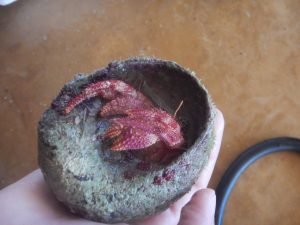We spent the whole morning analyzing our data from the coral and urchin stuff we did over the last two days. It was nice to just sit in a hammock staring out at the water that is an unnatural shade of blue and talk about data. I was actually dry for a few hours too which was pretty exciting. On most of this trip, I’ve either been in the water, getting rained on, or super sweaty.
In the afternoon we waded out to the reef that’s right next to the island. At first, it was super hot and disgusting because of the decomposing matter and the fact that our feet just went right into the ground respectively. But as we got out farther into the reef, it started to get cooler and we found super cool stuff. We picked up a ton of conchs, both alive and empty shells, tiny crabs, algae, and coral rubble. We brought everything back to the wet lab, where we have running ocean water, to get a better look at what we found. While we were still out collecting stuff we found a gigantic Caribbean spiny lobster. It was hiding under some coral. Scott spent at least 10 minutes trying to show it to me. I couldn’t see it because it was dark and because the lobster filled up literally the whole space and because apparently, I have crustacean blindness. When I finally saw it, I realized it was at least 3 feet long. It had long spindly antennae and stripy legs. On the way back to shore, we flipped over a piece of coral rubble and found 3 different lobsters. They skrted pretty quickly, but I think they were spiny spotted lobsters. There was one that was about 10 inches long, one that was 5 inches long, and one that was an inch and a half long. They looked like they might have been shrimp, but I knew they were lobster because of their thick antennae. In the tropics, you don’t find lobsters with the big claws like the ones in the supermarket, instead, they all have large antennae, either thick and spiny or wide and flat.
We had SO MANY CRUSTACEANS in the stuff we collected. We got a star eye hermit crab, whose eyes were gorgeous, and a white speckled hermit crab, who had slightly less gorgeous eyes.
There were a ton of crabs. Most of them were small green red ridged clinging crab, as in they were green but their common name is the red ridged clinging crab (because common names are useless). There were also a few other crabs one of which I think may have been a furcate spider crab which is a decorator crab. It was sorta fuzzy which I think was various algae it had covered itself in. We also had three tiny (<1cm) shrimp. One of them was a bumblebee shrimp which was kinda squat and covered in black and white stripes. I wasn’t able to ID the other two, one was super transparent and I have no clue what it was. The other had red and white striped arms and I think it was a sea anemone shrimp, but there are lots of small shrimp with red and white arms. There were a ton of tiny hermit crabs that I couldn’t identify too.
The most interesting thing that we found, I would argue, was a common mantis shrimp. It was about an inch and a half long. Mantis shrimp are known for either punching or spearing their prey. The common mantis shrimp is a spearing mantis shrimp so it has really sharp arms it can use to stab shrimp and what not. It would spend most of its time hiding under the large hermit crabs. But whenever it was disturbed, it would sometimes run up to one of the crabs and start attacking it. You could hear the pop as it punched the crabs with its arms and the crabs would totally freak out. I was showing all my crustaceans to the coast guard guys who are on this island with us and they thought the mantis shrimp was really cool. I really enjoyed teaching all these guys about the crustaceans that live in the ocean that is basically their backyard. I want to go into science communication and getting to talk to these guys about the crustaceans was a really cool chance to do it a little. There was a little bit of a language barrier, but I still got to show them the mantis shrimp and how violent it was and how beautiful the hermit crabs were and how pinchy the tiny crabs were.


